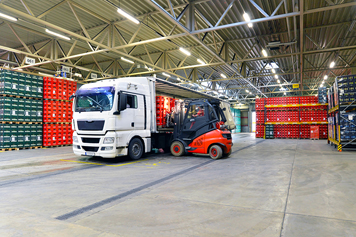Core processes
- Optimization of transport costs
- Route planning
- Capacity management
- Service provider selection
What is transport planning?

Transport planning primarily pursues the goal of optimizing arising transport costs against the background of rising energy prices and the shortage of cargo holds. However, the cost savings generated by the systematic design of transport networks and their control should not be at the expense of corporate strategy factors – such adherence to schedules and delivery quality. Balancing all of these aspects and directing them to the unerring direction is the central task of the transport or also route planning.
Successful planning and controlling (for the use of service providers and / or own transport resources) also requires the knowledge of the available freight requirements and capacities, as well as the knowledge about freight agreements and costs. Given that, it is possible to assign orders to the resources in the best possible way and to produce an adequate sequence for fast delivery (inbound and outbound). Cost-intensive empty trips and downtimes are reduced, the cargo space utilization is improved over all stages (for example, also in the multimodal environment for pre-begin, main and overrun) of the transport.
Different shipment sizes have to be differentiated and cleverly combined. Full loads may e.g. be combined with returns, partial loads can also be summarized to tours and can be transported either directly or in combination with other on-grid resources (trucks, containers, ...).
Different networks work together. A supplier network e.g. connects suppliers with the own plant or the plants of a customer. In a distribution network, goods are distributed from the manufacturer's production facility to the affiliated trading companies. In addition, there are freight forwarding networks that are operated by logistics service providers (LSP) and they connect several dispatching and receiving locations in parallel. These networks merge in the digital Supply Chain and can be optimally planned and measured. This allows you a better secure of the increasingly scarce cargo hold.
Functional areas
- Recording of transport demands
- Transport combination
- Selection of transport mode
- Simulation of transport scenarios
Which tasks does warehouse management entail?

Systematic transport and tour planning offers enormous potential to carry out a large number of processes as quickly and inexpensively as possible using suitable strategies and resources. In the course of this, the number of transport used, the duration of the transport and in the best case also the length of the route to be covered must be minimized.
The central tasks and functional areas of transport planning are:
- Definition of a transport network and definition of the transport relations
- Recording of transport requirements and consolidation of e.g. Inbound, outbound shipments, returns and works traffic
- Preliminary planning of the package structure
- Capacity and cost planning for transports
- Selection of means of transport and other resources
- Allocation of transport orders to your own fleet or to third-party vehicles from a logistics service provider
- Planning the transport routes taking into account shipment sizes
- Assignment of which customers to approach and in which order
- Calculation of transportation costs
- Simulation of different transport scenarios
- Reaction to influences such as traffic conditions, weather conditions etc.
- Service provider selection and assignment
The superordinate goal is to reduce costs for transport and handling while maintaining the specified performance – always in compliance with the delivery time. If influenced by transport planning, expenses for stocks that the owner of the goods to be transported must also take into account.
The optimal interaction of the systems creates clarity on questions such as:
- How much weight and volume is transported per individual transport or guaranteed total contingent?
- How many load carriers, for example containers, have been shipped within a specific traffic relationship?
- What are the average transportation costs?
- How reliably do shippers, freight forwarders and / or recipients work?
- What is the percentage of dangerous goods shipments compared to the total number of shipments?
- What are the distances between the destinations (warehouses, distribution centers, etc.) and recipients?
- What is the average time spent carrying out the individual transports?
Abbreviations
- LTL
- FTL
- FCL
- LCL
Transport strategies
The consistent application of individually suitable transport strategies can significantly increase the performance of a transport system with reduced vehicle use.
The most common transport strategies include:
LTL – Less than truck load
LTL (Less Than Truckload) marks partial loads. Dispatchers generally endeavor to load a partially loaded truck with additional partial loads so that the journey pays off. At the same time, however, the number of loading and unloading points increases, where waiting times can be difficult to calculate, so that the transport time increases. For this reason, it is a good idea to cover longer distances with only a partial load for shipments that are time-sensitive.
FTL – Full truck load
FTL (Full Truck Load) stands for full loads. In such a case, the truck is fully loaded with just one load. This benefits drivers, carriers and customers alike. Waiting times occur only once at the loading location and at the recipient and the effort for notification and billing decreases as well as for load securing. FTL is therefore the fastest and most efficient variant for all those involved in the transport process.
FCL – Full container load
FCL (Full container load) refers to fully loaded containers that the transporter makes available to the shipper at a specially assigned stacking place in the terminal. In the course of shipping, the containers can then be handed over to the correct parking space inside using IT.
LCL – Less than full container load
The LCL strategy stipulates that the transporter only transports general cargo and feeds it to the terminal. His area of responsibility also includes the merging with other loads in a container to be shipped and the unloading of the shipments at the arrival port.
What is a TMS or a TPS?
![[Translate to English:] SAP TM LKW Routenplanung | IGZ [Translate to English:] SAP TM LKW Routenplanung | IGZ](/fileadmin/user_upload/Warehousing/SAP_Module/SAP_TM/igz-sap-tm-transport-lkw-routenplanung.jpg)
TMS (Transport Management System) and TPS (Transport Planning System) are usually used interchangeably and address shippers, logistics service providers and freight forwarders who want to use automation to improve their transport planning and execution.
A transport management system or transport planning system (e.g. SAP TM) is a business software that manages transport needs and supports users in organizing transport networks and handling goods movements efficiently and at the same time in a service-oriented manner. A TMS or TPS is responsible for the entire control, controlling and continuous optimization of capacities, resources and route guidance.
Modern TMS / TPS, which are mostly used in complex transport networks, are scalable and therefore future-proof. They also have Track & Trace and reliable event management functions, thus enabling optimized, synchronized transport and logistics performance.
TMS
Transport Management Systems (TMS) are used to plan, control and optimize single and multi-stage as well as multimodal transports. TMS create transparency about the real flows of information and goods, enable reactions in real time and are generally usable globally.
TPS
Transport planning systems (TPS) are mostly synonymous with transport management systems (TMS), possibly even more focused on tour planning functions.
SAP TM
As part of the SAP SCE or SAP S/4 platform, SAP Transportation Management (SAP TM) maps the transport logistics across locations and offers comprehensive functions for the automation and optimization of transport processes. The planning and tendering as well as the implementation, tracking and freight cost accounting are supported and customers benefit from a significantly higher range of functions and ERP integration than with non-SAP TM systems.
SAP LE-TRA
The SAP LE-TRA (Logistics Execution - Transport) module (discontinued by SAP) is used to plan transports, modes of transport and shipping methods and also maps transport management processes integrated with SAP ERP. SAP TM is a more powerful alternative and successor with SAP S/4.
GIS-System
The abbreviation GIS stands for "geographic information system". With the help of these applications, spatial data can be digitally recorded, analyzed and processed. Numerical and graphic presentations are also possible.
With regard to SAP TM, data from such systems (e.g. Google Maps, PTV, Here Maps ...) is used for planning and execution based on real geocoded information (road guidance, bridges, underpasses, toll roads, loading and unloading locations) and real-time data (traffic, closures ...) used for optimized planning and execution.
Advantages of ERP integration
- Integrated digital supply chain
- Substitution of complex interfaces
How important is ERP integration?

Communication with self-contained transport management systems is usually only possible via complex interfaces. Integrated solutions, on the other hand, are part of the ERP environment, so that all the data and information required for planning, controlling, and optimizing the transport processes is prepared transparently and uniformly in a single system. Users can act much more flexibly and are able to react to unscheduled changes in the general conditions.
The further you look into the transport or supply chain, the better you can localize any faults at an early stage. In order to maintain the agreed service level, suitable countermeasures can be initiated, for example by switching to alternative routes, means of transport or stocks. An integrated transport management of this type also creates the prerequisites for being able to meet the requirements of Logistics 4.0.
Tasks
- transport planning
- Transportation cost management
- Promotion of interaction between logistics and transport processes
- Seamless handling of the transport chain
What are the tasks of a transport management system?

A modular and scalable transport management system seamlessly maps the entire transport process – from order entry through planning, tendering, scheduling and processing including monitoring to freight cost recording and invoicing. The synchronized interaction of a transport management system (e.g. SAP TM) with warehouse management and material flow control (e.g. SAP EWM / SAP MFS) enables effective, automated formation of order-related picking waves and transport units and thus ensures reliable notification and provision for shipping.
At the same time, the prerequisites for the direct integration of gate planning (loading / unloading gates) and yard management as well as time slot booking are created. Central shipping control takes place in the SAP environment via the shipping cockpit in SAP EWM and the loading status in SAP TM. At the same time, the best possible distribution of freight is ensured across the modes of transport: trucks, trains, ships and planes.
Processes can be standardized, costs, as well as climate and environmentally harmful CO² emissions can be significantly reduced.
Classification
- Self-sufficient TMS ('stand-alone solutions')
- ERP-integrated TMS
What types of transport management systems are there?
In practice, there are both autonomous and ERP-integrated transport management systems. The self-sufficient TMS are "stand-alone solutions", i.e. self-contained systems, which can generally only communicate with other, company-relevant applications via complex interfaces and usually have no open basis (black box, no open source). These systems are generally not considered standard software.
The particular advantage of integrated systems and standard software, such as SAP TM, however, is that they are part of the ERP environment and the complete SAP suite. As a result, all information that is required for the planning, control and optimization of the transport processes within a supply network is available transparently and unified in one application. This also includes data from ordering, production, accounting, purchasing, storage and inventory management.
The advantages of SAP integrated functions and business processes for transport management ensure greater transparency of processes, precise planning of transport processes and efficient processes for distribution and warehousing – they form the heart of logistics.
Users of an integrated transport management system can act much more flexibly and are able to react to unscheduled changes in the general conditions. At the same time, considerable savings potential can be leveraged at the transport level.
Advantages of SAP TM
- fully supported SAP integration
- Standard software with maximum functionality
- Future and investment security
Advantages SAP Transportation Management (SAP TM)
As part of the SAP Digital Supply Chain, SAP TM simplifies transport management and also enables warehouse logistics processes to be integrated into the transport network. The spectrum ranges from an overview and procurement of transport capacities to the consolidation of freight requirements and transport planning to tendering, invoicing / checking as well as communication, track & trace and warehouse management. Using an implemented optimization algorithm, it is possible to automatically determine the most efficient transport plan in individual cases.
Advantages of SAP TM in detail:
- Integration of ERP and transport processes
- Integrated process control for storage and transportation
- Transparency about capacities (load carriers, transport resources, ...)
- Optimization of freight consolidation (inbound, outbound, stock transfers, returns, ...)
- Multi-level, multimodal freight management
- treamlined, automated and efficient processes
- traceability
- resource optimization
- Global condition and contract management (carrier conditions)
- Global fee and cost management
- Establishing best practices
- Real-time reaction - also to deviations from the originally created transport plan
SAP Global Trade Service (SAP GTS) for customs processing and SAP Event Management (SAP EM), SAP Global Track & Trace (GTT) and Logistics Business Network (LBN) are also integrated. In addition, SAP TM offers manual planning functions that can be used, for example, to change routes or to adapt load distributions using a 3D model.


